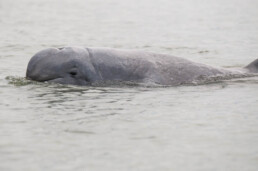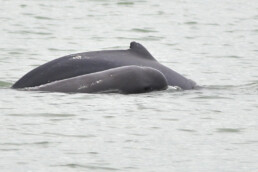With its rounded head, expressive face, and remarkable adaptability, this species is unlike any other. Surprisingly, it is closely related to the mighty orca, or killer whale, despite its smaller size and freshwater habitat. Unlike its ocean-dwelling cousins, the Irrawaddy dolphin thrives in rivers, lakes, and coastal waters across Southeast Asia. But despite its charm and ecological importance, this incredible creature is in serious trouble.

Cambodia, Mekong Photo: Stefan Brending
Urgent Protection Needed
The Irrawaddy dolphin is classified as Endangered throughout its entire range, with several populations teetering on the edge of extinction. In places like Cambodia’s Mekong River, Laos, and parts of Myanmar, its status is even more dire—Critically Endangered. Habitat loss, entanglement in fishing gear, and the construction of dams have decimated their numbers. Because they live close to shore they have been more impacted by people and are particularly susceptible to drowning in gill nets.
Without urgent action, we risk losing these extraordinary animals forever.
The MCC team delpoying Fisheries Production Structures in Cambodian waters. These structures dissuade the use of nets in protected areas. The blocks also assist the restoration of sea grass beds and serve as artificial reef.
Distribution map of Irrawaddy dolphin

Source: 蕭漫 – Own work based on: Minton, G.; Smith, B.D.; Braulik, G.T.; Kreb, D.; Sutaria, D. & Reeves, R. (2017). “Orcaella brevirostris“. The IUCN Red List of Threatened Species 2017
Hope in Cambodia
Despite these challenges, there is hope. In Cambodia, our partners, Marine Conservation Cambodia, are leading the charge in protecting Irrawaddy dolphins—and they’re making a real difference.
Cambodia has enacted strong legal protections for the Irrawaddy dolphin. But laws alone aren’t enough. Sustained commitment, enforcement, and increased resources to ensure long-term survival are needed. The world must recognize that the Irrawaddy dolphin is an irreplaceable treasure—and protecting it requires urgent, collective action.

Mother and calf, Photo: Dibyendu Ash
What You Can Do
The future of the Irrawaddy dolphin is not set in stone. By supporting conservation initiatives, spreading awareness, and backing sustainable development policies, we can turn the tide for this incredible species. Every action counts. Let’s ensure that future generations can marvel at the Irrawaddy dolphin in the wild—not just in history books.
